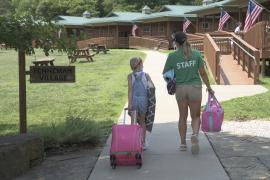It is a common refrain that the college years best represent "the time of our lives," replete with newfound independence and denoting fulfillment of academic, social, emotional, and workforce development goals. In reality, for many it may be something quite different — and quite unsettling.
For a growing cohort of college students, these formative years are filled with angst, anxiety, and full-blown mental illness, exacerbated by stress, unhealthy lifestyles, and, arguably, a lack of adequate preparation for one of the most important life transitions they will make (Gallagher, 2014).
The Evidence
Just over a year ago, The Jed Foundation, Partnership for Drug-Free Kids, and The Jordan Porco Foundation released the results of a national "First-Year College Experience" survey exploring the challenges associated with young adults' transition from high school to college. The poll of 1,502 first-year students measured emotional preparedness for college, which is defined by the sponsoring organizations as "the ability to take care of oneself, adapt to new environments, control negative emotions or behavior, and build positive relationships" (The Jed Foundation, 2016).
These four key metrics are deemed to be predictive of overall success in the higher education environment. Unfortunately, many young people don't fare so well.
The data say that a whopping 60 percent wish they had received better emotional preparation for the transition to college. This is especially the case among those who:
- Had a lower GPA (66 percent versus 55 percent higher GPA)
- Regularly consumed drugs or alcohol (65 percent versus 58 percent who did not)
- Considered transferring or transferred to a different school (70 percent versus 56 percent who did not)
- Rated their overall college experience as "terrible/poor" versus "fair" or "excellent/good" (85 percent versus 68 percent and 51 percent)
Significantly, more than half of students (51 percent) found it difficult at times to get emotional support at college when they needed it.
And that's for those students who actually made it to college.
There is also rising alarm among educators and mental health practitioners about a phenomenon that has come to be known as "summer melt" — a process through which a significant number of young people planning on attending college in the fall never actually get there.
According to the Center for Education Policy Research at Harvard University, some 10 percent to 40 percent of young people fail to enroll in college for the fall semester after graduating from high school — an occurrence that seems to be more common among individuals of lower socioeconomic status (2016).
In any case, such "melting" flies in the face of predictability as the students have already "completed key college-going steps" (Castleman et al, 2013), such as applying, being accepted, and seeking financial aid.
Here, too, investigators seek answers about how to better support young people preparing for change.
The Outcomes
The challenges facing youth at this critical juncture of development are many and manifest in soaring rates of stress, mood disorders, and, sadly, suicides.
The American Psychological Association (APA), reporting on measurements of stress among 1,950 adults ages 18 and over and 1,018 teens ages 13 to 17, concluded that both cohorts are experiencing similar levels of stress, which results in unhealthy behaviors related to sleeping, eating, and exercising. It also noted youth reporting feelings of sadness or depression (30 percent) (APA, 2014).
Adam Rosen, a 2016 counselor at Cape Cod Sea Camps and currently a first-year student at Tufts University, reflected on those trends, telling me, "Along with the heaps of stress that the admissions process brings are pressures to do more. I was told many times that I wouldn't get into my first choice college if I didn't play sports, perform music, study hard, and have strong other extracurricular activities. When we had leisure time, we were expected to fill it with something productive. It's like continually racing toward the top. Every single high school kid I knew succumbed to valuing themselves based on where they were accepted. This evaluation of one's worth is incredibly dangerous because the process itself is volatile and suspenseful. The fear that all your hard work for four years of high school could amount to your attending a 'safety school' is exacerbated by a long waiting period and a common practice of comparing oneself to one's peers."
When stress turns into anxiety and depression, the stakes for those suffering and those trying to help skyrocket. To that point, 86 percent of higher education officials responsible for mental health services say they are seeing a steady increase of students who arrive on campus already having been prescribed psychiatric medication. For what are these emerging adults being treated? According to a 2014 report from the National Survey of College Counseling Centers (Gallagher, 2014), the diagnoses and "issues" include anxiety disorders and clinical depression, along with problems related to learning disabilities, self-injury (such as cutting to relieve anxiety), and prior sexual abuse. In totality, all of the mental health disorders commonly diagnosed among young people paint a disturbing portrait of pain and suffering.
Some of the most common forms of distress reside in a plethora of anxiety-related disturbances, including agoraphobia, generalized anxiety disorder, panic disorder, obsessive-compulsive disorder, separation anxiety disorder, social anxiety disorder, and specific phobia. Those experiencing significant anxiety often view new environments and experiences (such as going to college) as threatening more so than as opportunities for learning and personal growth (Falk and Walkup, 2015).
Elizabeth Kieff, MD, a psychiatrist in Chicago with years of undergraduate counseling experience, told me, "Such disorders are often amplified by the relative lack of structure in college. Anxiety loves unpredictability, which can be abundant in a setting rife with more free time and personal choice."
Beyond anxiety lurks its close cousin depression. The National Institute of Mental Health (NIMH) calls it "a common but serious mood disorder," which results in symptoms that affect how people feel, think, and function on a daily basis (2016).
In her cover story, "Students Under Pressure," published by the APA, journalist Amy Novotney states, "About one-third of US college students had difficulty functioning in the last 12 months due to depression . . . according to the 2013 National College Health Assessment, which examined data from 125,000 students from more than 150 colleges and universities." Even more concerning, Novotney quotes Pennsylvania State University psychologist Ben Locke, PhD, as saying, "More than 30 percent of students who seek services for mental health issues report that they have seriously considered attempting suicide at some point in their lives, up from about 24 percent in 2010" (Novotney, 2014).
Suicide was, in fact, cited by the Centers for Disease Control and Prevention (CDC) as the second-leading cause of death among 15- to 24-year-olds in 2013 (2015). And the Suicide Prevention Resource Center (SPRC) lists suicide as one of the leading causes of death among college students. It adds, "In addition, many other college and university students have suicidal thoughts and attempt suicide," drawing a distinction between intent and "success" (SPRC, 2014).
A similar assessment was made last spring by Sally Curtin, a statistician with the CDC's National Center for Health Statistics, which released a report that April showing suicides in the US at a near-30- year high (Curtin et al, 2016). Curtin told National Public Radio, "The deaths are but the tip of the iceberg" (Bichell, 2016).
The Aftermath
Amid the stress and mental disturbance (and likely in part because of a shortage of available mental health services for adolescents and emerging adults) (National Alliance, 2013), there's a lot of self-medicating taking place on both sides of the bridge to college — and not a good kind.
For example, a study from the Center for Adolescent Research and Education (CARE) revealed that one in six high school students staying overnight on college campuses as part of their school selection process reported using alcohol, with more than half of them (51 percent) saying it was the first time they drank (Wallace, 2012). The same study noted that more than one-third of first-year, first-semester college students used alcohol — again, many (26 percent) for the first time (Wallace, 2014). This is particularly noteworthy as decision-making during this transitional time may translate into normative behavior throughout the college tenure.
It is also important to note that the National Institute on Alcohol Abuse and Alcoholism (NIAAA) states, "Each year, drinking affects college students, as well as college communities, and families." NIAAA lists as the consequences of drinking the following grim statistics (2016).
- Death: 1,825 college students between the ages of 18 and 24 die each year from alcohol-related, unintentional injuries.
- Assault: More than 690,000 students between the ages of 18 and 24 are assaulted by another student who has been drinking.
- Sexual abuse: More than 97,000 students between the ages of 18 and 24 are victims of alcohol-related sexual assault or date rape.
- Injury: 599,000 students between the ages of 18 and 24 receive unintentional injuries while under the influence of alcohol.
- Academic problems: About 25 percent of college students report academic consequences of their drinking including missing class, falling behind, doing poorly on exams or papers, and receiving lower grades overall.
- Health problems/suicide attempts: More than 150,000 students develop an alcohol-related health problem, and between 1.2 and 1.5 percent of students indicate that they tried to commit suicide within the past year due to drinking or drug use.
A recent series of suicides among high school students in communities such as Palo Alto, California, and Westchester County, New York, and on college campuses ranging from the University of Pennsylvania to Tulane University, to name but a few, suggest an urgent epidemic of mental illness and self-destruction.
The Antidote
With more of those proverbial icebergs looming on the horizon, a scramble is on to figure out some solutions. And here there are some reasons for optimism.
In January 2016, the Harvard University Graduate School of Education issued a report, "Turning the Tide," representing the recommendations of a consortium of colleges and universities calling for sweeping changes in the admissions process. The goal? To promote more evenly balanced lives for high school students and to motivate a real commitment to community service. Among the recommendations are ones to increase test-optional admission schools, discourage overloading of advanced placement classes, and encourage more meaningful extracurricular involvement (Weissbourd et al, 2016).
Commenting on this effort, Kedra Ishop, associate vice president for enrollment management at the University of Michigan, said, "Escalating achievement pressure is not healthy for our youth. Young people are suffering from higher rates of depression, anxiety, and substance abuse as they juggle the demands of their lives . . . 'Turning the Tide' promotes the quality of academic engagement over the quantity of achievements in college admissions" (Harvard GSE, 2016).
For its part, The Jed Foundation, which is the nation's leading organization that works to promote emotional health and prevent suicide among college and university students, is also doing some innovative programming, such as the following (2016):
- The JED Campus Program: a nationwide initiative designed to empower schools with a framework and customized support to enhance student mental health and help with substance abuse and suicide prevention efforts
- ULifeline: a 24/7 text and call helpline
- Half of Us: an effort to raise awareness about the prevalence of mental health issues on campus and help direct students to available resources
- Love Is Louder: a campaign created with actress Brittany Snow and mtvU to support anyone feeling mistreated, misunderstood, or alone
- Set to Go: a new program for high school students gearing up for the transition to college
The Summer Camp Solution
Of course, there is an important role that summer camps can play — and have been playing — in preparing young people for most of life's transitions, including the one to college.
Annually, some 7.1 million children and teens attending more than 2,400 camps accredited by the American Camp Association (ACA, 2016), as well as the approximately 300,000 emerging adults working at them, thrive in "caring communities." These communities are built on principles of inclusion, support, respect, friendship, empathy, and compassion and engender tangible benefits of independence, self-confidence, leadership, social skills, and an openness to new experiences (ACA, 2005). Not coincidentally, these are the very traits that will help to facilitate a smooth transition out of high school and into college.
The mom of one camper told me, "Camp not only helps them get into college, it helps them succeed in college" because they don't waste a year trying to figure it all out.
Indeed, Dr. Kieff, herself a former camp counselor and sailing instructor, says, "Camp provides kids with a chance for experiential learning of skills that can affect their ability to self-regulate and make good choices when they transition to college. This includes everything from learning how to modify sleep — and experiencing the consequences of feeling tired at camp the day after poor sleep — to making selections in the dining hall and finding out what activities are authentically interesting to them. Most important, camp gives kids and emerging adults a place to practice navigating relationships with peers, role models, and mentors in a way that can directly translate to college and beyond."
Former camper John Calicchio, a senior at Kent School in Connecticut and a student member of the national advisory board at CARE, says that camp helped him prepare for boarding school and college. Calicchio told me, "Going to camp was one of the best decisions I made in terms of being prepared for life's next steps. It was the first time I was away from my home and family for a long period of time. Summer camp teaches you to become independent and to develop social skills. Of course, I am still a bit anxious and nervous for my transition to college, but I feel much more confident after my time at camp. It's a great experience and pays off in the future."
Summers at camp prepare young people for the future and, hopefully, the time of their lives.
|
Five Things Summer Camps Can Do To Help Youth In Transition As camp directors (CCSC, 2016), we can encourage campers and counselors to:
|
References
ACA. (2016). American Camp Association. Retrieved from ACAcamps.org/press-room/ACA-facts-trends.
ACA. (2005). Directions: youth development outcomes of the camp experience. American Camp Association. Retrieved from ACAcamps.org/ resource-library/research/directions-youthdevelopment- outcomes-camp-experience.
APA. (2014, February 11). American Psychological Association survey shows teen stress rivals that of adults. Stress in America. Retrieved from apa.org/ news/press/releases/2014/02/teen-stress.aspx (27 July 2016).
Bichell, R. (2016). Suicide rates climb in U.S., especially among adolescent girls. Shots: Health News from NPR. National Public Radio. Retrieved from npr.org/sections/healthshots/ 2016/04/22/474888854/suicide-ratesclimb- in-u-s-especially-among-adolescent-girls
Castleman, B., Page, L., & Snowdon, A. (2013). SDP summer melt handbook: A guide to investigating and responding to summer melt. Strategic Data Project. Center for Policy Education Research. Retrieved from http://sdp.cepr.harvard.edu/ summer-melt-handbook
CCSC. (2016). The CCSC experience. Cape Cod Sea Camps. Retrieved from capecodseacamps.com/ resident-camp
CDC. (2015). Understanding suicide. Violence prevention fact sheet 2015. Centers for Disease Control and Prevention. Retrieved from cdc.gov/ violenceprevention/pdf/suicide_factsheet-a.pdf
Curtin, S., Warner, M., & Hedegaard, H. (2016, April). Increase in suicide in the United States, 1999–2014. National Center for Health Statistics. Youth suicide. Injury Prevention and Control: Division of Violence Prevention. Centers for Disease Control and Prevention. Retrieved from cdc.gov/nchs/products/databriefs/db241.htm
Falk, A., & Walkup, J. (2015, August 19). Anxiety disorders in children, adolescents, and emerging adulthood. PsychiatryAdvisor.com. Retrieved from psychiatryadvisor.com/about-us/section/4046
Gallagher, R. (2014). National survey of college counseling centers. University of Pittsburgh and American College Counseling Association. Retrieved from collegecounseling.org/wp-content/ uploads/NCCCS2014_v2.pdf
Harvard Graduate School of Education. (2016, January 20). Turning the tide: Inspiring concern for others and the common good through college admissions. Newseditor. Retrieved from gse.harvard.edu/news/16/01/turning-tideinspiring- concern-others-and-common-goodthrough- college-admissions
Harvard University. (2016) SDP summer melt handbook. Center for Education Policy Research. Retrieved from http://sdp.cepr.harvard.edu/ summer-melt-handbook
The Jed Foundation. (2016). JED campus program. Retrieved from thecampusprogram.org
The Jed Foundation. (2016). Love Is Louder. Retrieved from loveislouder.com
The Jed Foundation. (2016). Promoting mental health and preventing suicide. Retrieved from jedfoundation.org
The Jed Foundation. (2015, October 8). Students who feel emotionally unprepared for college more likely to report poor academic performance and negative college experience. Retrieved from http:// settogo.org/wp-content/uploads/2015/10/First- Year-College-Experience-Survey-Press-Release- FINAL.pdf
The Jed Foundation. (2016). ULifeline. Retrieved from ulifeline.org
The Jed Foundation and mtvU. (2016). Half of Us. Retrieved from halfofus.com
The Jordan Porco Foundation. (2016). We're in it for life. Retrieved from rememberingjordan.org
National Alliance. (2013, September 30). Recommendations for improving mental health services in Medicaid. The National Alliance to Advance Adolescent Health. Retrieved from thenationalalliance.org/pdfs/ Recommendations%20for%20Improving%20 Mental%20Health%20Services%20in%20 Medicaid_Sep13.pdf
NIAAA. (2016). College drinking. National Institute on Alcohol Abuse and Alcoholism. National Institutes of Health. Retrieved from niaaa.nih.gov/ alcohol-health/special-populations-co-occurringdisorders/ college-drinking
NIMH. (2016, May). Depression. National Institute of Mental Health. National Institutes of Health. Retrieved from nimh.nih.gov/health/topics/ depression/index.shtml
Novotney, A. (2014, September). Students under pressure. Monitor on Psychology. Retrieved from apa.org/monitor/2014/09/cover-pressure.aspx
Partnership for Drug-Free Kids. (2016). Retrieved from drugfree.org
Set to Go. (2016). About set to go. Retrieved from http://settogo.org/about-set-to-go
Suicide Prevention Resource Center. (2014). Suicide among college and university students in the United States. Sprc.org. Retrieved from hsprc.org/sites/sprc.org/files/library/SuicideAmongCollegeStudentsInUS.pdf?utm_source=Weekly+Spark+04%2F10%2F2015&utm_ campaign=Weekly+Spark+April+10%2C+ 2015&utm_medium=email
Wallace, S. (2014, March 12). Lonely street of dreams. The Huffington Post. Retrieved from huffingtonpost.com/stephen-graywallace/lonely-street-of-dreams-collegedepression_ b_4570944.html
Wallace, S. (2012). A higher education — a long, winding and potentially dangerous road to college admission. Psychology Today. Retrieved from psychologytoday.com/blog/decisions-teensmake/ 201206/higher-education
Weissbourd, R., Thacker, L., Ross Anderson, T., Cashin, A., Falk Feigenberg, L., & Kahn, J. (2016, January). Turning the tide: Inspiring concern for others and the common good through college admissions. Making Caring Common. Harvard Graduate School of Education. Retrieved from http://mcc.gse.harvard.edu/files/gse-mcc/ files/20160120_mcc_ttt_report_interactive .pdf?m=1453303517
Stephen Gray Wallace, MS Ed, is president and director of the Center for Adolescent Research and Education (CARE), a national collaborative of institutions and organizations committed to increasing positive youth outcomes and reducing negative risk behaviors. He has broad experience as a school psychologist and adolescent/ family counselor and serves as director of counseling and counselor training at Cape Cod Sea Camps, a member of the professional development faculty at the American Academy of Family Physicians and ACA, and a parenting expert at kidsinthehouse.com and NBCUniversal's parenttoolkit.com. He is also an expert partner at the Risk Assistance Network & Exchange (RANE) and was national chairman and chief executive officer at SADD for more than fifteen years. Additional information about Stephen's work can be found at StephenGrayWallace.com.
Summit Communications Management Corporation 2016. All Rights Reserved
Photo courtesy of Camp Westwind, Otis, Oregon.




